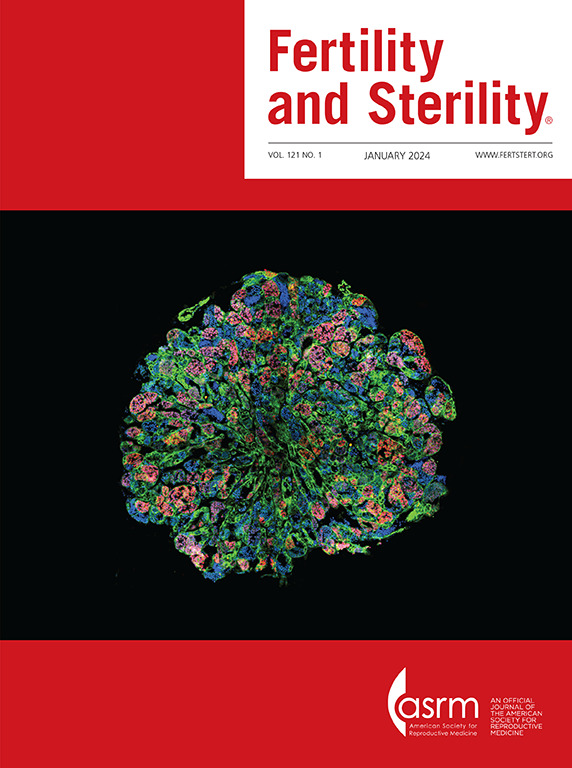Perinatal outcomes of women with recurrent pregnancy loss undergoing frozen embryo transfer from the Society of Assisted Reproductive Technology database
IF 6.6
1区 医学
Q1 OBSTETRICS & GYNECOLOGY
引用次数: 0
Abstract
Objective
To assess whether infants born to women with a history of recurrent pregnancy loss (RPL) have an increased risk of adverse perinatal outcomes after frozen embryo transfer (FET) compared with women without a history of infertility or RPL.
Design
Retrospective cohort study utilizing the Society for Assisted Reproductive Technology Clinic Outcomes Reporting System database between 2014 and 2020.
Subjects
Patients in the Society for Assisted Reproductive Technology Clinic Outcomes Reporting System database who underwent their first FET resulting in live birth either with a diagnosis of RPL (cases n = 3,299) or without a history of RPL or infertility, the comparison population being tubal ligation (TL) only (n = 1,408).
Exposure
Recurrent pregnancy loss.
Main Outcome Measures
Low birthweight (<2,500 g), additional outcomes included gestational age (continuous), birthweight (continuous), preterm delivery (<37 weeks), mode of delivery, and neonatal death, defined as death before the completion of the 28th day of life.
Results
We observed no statistically significant difference in low birthweight, birthweight overall, mode of delivery, or risk of neonatal death between patients with RPL compared with women with TL who underwent their first FET, resulting in live birth. Patients with history of RPL compared with TL utilizing FET were more likely to have a later gestational age at delivery. Patients with RPL were also less likely to have a preterm delivery (imputed adjusted odds ratio, 0.75; 0.64–0.89) than the patients with TL. Furthermore, performing preimplantation genetic testing for aneuploidy (PGT-A) in both patients with RPL or TL did not impact perinatal outcomes compared with patients who did not undergo PGT-A.
Conclusion
Patients with history of recurrent pregnancy loss do not have an increased risk of adverse perinatal outcomes when they undergo FET compared with patients without infertility or RPL. In addition, performing in vitro fertilization/PGT-A in patients with RPL does not adversely impact birth outcomes of their infants.
Resultados perinatales de mujeres con aborto de repetición sometidas a transferencia de embrión congelado según la base de datos de la Sociedad de Tecnología de Reproducción Asistida.
Objetivo
Evaluar si los niños nacidos de mujeres con antecedentes de pérdida recurrente del embarazo (RPL), tienen un mayor riesgo de resultados perinatales adversos tras transferencia de embriones congelados (FET) en comparación con mujeres sin antecedente de infertilidad o RPL.
Diseño
Estudio retrospectivo de cohorte utilizando la base de datos del Sistema de Informe de Resultados Clínicos de la Sociedad de Tecnología de Reproducción Asistida (SART) entre 2014 y 2020.
Pacientes
Pacientes en la base de datos del Sistema de Informe de Resultados Clínicos de la Sociedad de Tecnología de Reproducción Asistida que se sometieron a su primera FEC resultando en un nacido vivo con un diagnóstico de RPF (casos n=3,299) o sin antecedentes de RPL o infertilidad, siendo la población de comparación solo ligadura tubárica (TL) (n=1,408).
Medida de resultado principal
Bajo peso al nacer (<2,500 g), otros resultados adicionales incluyeron edad gestacional (continua), peso al nacer (continuo), parto prematuro (<37 semanas), modalidad del parto y muerte neonatal, definida como muerte antes de cumplir los 28 días de vida.
Resultados
No observamos diferencias estadísticamente significativas en el bajo peso al nacer, el peso al nacer general, el tipo de parto, o el riesgo de muerte neonatal entre pacientes con RPL en comparación con mujeres con TL que se sometieron a su primera FET resultando en un nacido vivo. Las pacientes con antecedentes de RPL, en comparación con las TL que utilizaron FET tuvieron mayor probabilidad de tener una edad gestacional más tardía al momento del parto. Las pacientes con RPL también tuvieron menor probabilidad de tener un parto prematuro (odds ratio ajustada imputada: 0.75; 0.64-0.89) que las pacientes con TL. Además, la realización de pruebas genéticas preimplantacionales para aneuploidía (PGT-A) tanto en pacientes con RPL como con TL no afectó los resultados perinatales en comparación con pacientes que no se sometieron a PGT-A.
Conclusión
Las pacientes con antecedentes de aborto de repetición no presentan un riesgo aumentado de resultados perinatales adversos cuando se someten a FET en comparación con pacientes sin infertilidad o RPL. Además, la realización de fecundación in vitro/PGT-A en pacientes con aborto de repetición no afecta negativamente el desarrollo fetal de sus bebés.
辅助生殖技术协会数据库中接受冷冻胚胎移植的复发性妊娠失败妇女的围产期结果。
目的评估与无不孕史或复发性妊娠丢失(RPL)史的妇女相比,有复发性妊娠丢失史的妇女在冷冻胚胎移植(FET)后所生的婴儿围产期不良结局的风险是否会增加:设计:利用2014年至2020年间辅助生殖技术协会诊所结果报告系统(SART CORS)数据库进行回顾性队列研究:SART CORS 数据库中接受首次 FET 并导致活产的患者,诊断为 RPL(病例 n=3299)或无 RPL 或不孕史,对比人群仅为输卵管结扎(TL)患者(n=1408):主要结果:低出生体重(出生第三天):我们观察到,与输卵管结扎女性相比,RPL 患者在首次接受 FET 并获得活产的低出生体重、总出生体重、分娩方式或新生儿死亡风险方面均无明显统计学差异。与使用 FET 的 TL 相比,有 RPL 史的患者分娩时的胎龄更晚(p 结论:与没有不孕症或复发性妊娠流产史的患者相比,有复发性妊娠流产史的患者接受 FET 并不会增加围产期不良结局的风险。此外,对 RPL 患者进行体外受精/PGTA 并不会对婴儿的出生结局产生不利影响。
本文章由计算机程序翻译,如有差异,请以英文原文为准。
求助全文
约1分钟内获得全文
求助全文
来源期刊

Fertility and sterility
医学-妇产科学
CiteScore
11.30
自引率
6.00%
发文量
1446
审稿时长
31 days
期刊介绍:
Fertility and Sterility® is an international journal for obstetricians, gynecologists, reproductive endocrinologists, urologists, basic scientists and others who treat and investigate problems of infertility and human reproductive disorders. The journal publishes juried original scientific articles in clinical and laboratory research relevant to reproductive endocrinology, urology, andrology, physiology, immunology, genetics, contraception, and menopause. Fertility and Sterility® encourages and supports meaningful basic and clinical research, and facilitates and promotes excellence in professional education, in the field of reproductive medicine.
 求助内容:
求助内容: 应助结果提醒方式:
应助结果提醒方式:


